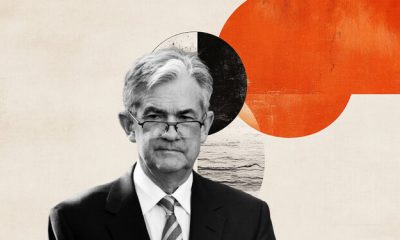

others
US Dollar under pressure amid tariff risks, Fed uncertainty – Crypto News
- The US Dollar starts the week under pressure, slipping against major currencies on Monday.
- Political pressure on Fed Chair Jerome Powell intensifies after DOJ referral over alleged perjury.
- The DXY US Dollar Index is retesting a critical support zone near 98.80-98.00, showing signs of fading momentum.
The US Dollar (USD) kicks off the week on the back foot, slipping against major currencies in Monday trading. Investors are reacting to renewed trade tensions ahead of the August 1 deadline and a generally cautious market sentiment. Despite mostly solid US economic data lately, the Greenback is feeling the heat from ongoing uncertainty surrounding the US President Donald Trump administration’s ramped-up tariff threats and increasing political pressure on the Federal Reserve (Fed) to cut interest rates.
Concerns over the Fed’s independence have intensified after Rep. Anna Paulina Luna (R-Fla.) formally referred Chair Jerome Powell to the Department of Justice (DOJ) for criminal charges, accusing him of two specific instances of lying under oath during his congressional testimony about the Federal Reserve’s $2.5 billion headquarters renovation. While legal consequences remain uncertain, the political overhang is fueling investor jitters and adding a fresh layer of uncertainty to an already fragile market sentiment. The timing is particularly sensitive, as markets continue to grapple with mixed signals from Fed officials regarding a potential July interest rate cut and lingering doubts about the central bank’s ability to operate free from political interference.
Speaking on CNBC Monday, Treasury Secretary Scott Bessent launched a sharp critique of the Federal Reserve, stating that it’s time to “examine the entire institution and whether they’ve been successful.” His remarks added to growing unease about potential political pressure on the Fed, denting confidence in its independence and casting uncertainty over the policy outlook. Bessent went further, pushing back against the Fed’s inflation warnings. “They’re fearmongering over tariffs,” he said, insisting inflation remains under control.
The US Dollar Index (DXY), which measures the Greenback against six major currencies, extends its intraday descent after logging two consecutive weekly gains. As of the American trading hours, the index is trading near 97.90, retreating further amid mounting policy tension and shifting interest rate expectations.
After a turbulent week marked by fresh tariff threats and reports that President Trump considered firing Fed Chair Jerome Powell, a claim he later downplayed as “highly unlikely”, the US Dollar Index still managed to hold modest gains.
Mixed signals from Fed officials on a possible July rate cut added to the uncertainty, but strong economic data, including solid Retail Sales and a healthy labor market, lent support to the Greenback. The DXY ended the week up 0.62%, showcasing its resilience in the face of political noise and policy tensions. However, the broader trend suggests underlying weakness in the US dollar.
Looking ahead, the US economic calendar is relatively light, and the Fed is currently in its blackout period ahead of the July 30 policy meeting, meaning that no official comments on monetary policy from Fed members are expected. While Fed Chair Jerome Powell and Governor Michelle Bowman are scheduled to speak on Tuesday, their remarks are expected to avoid policy topics. With the Fed sidelined, markets will look to Thursday’s preliminary S&P Global Purchasing Managers Index (PMI) data and Friday’s Durable Goods orders for fresh clues on the US economy and the Fed’s next move.
Market Movers: BRICS, EU tariff risks mount, GENIUS act becomes law
- The yield on the US 10-year Treasury fell to around 4.40% on Monday, marking its fourth straight daily decline. The drop comes as investors turn more cautious amid rising trade tensions, especially with looming tariff deadlines involving the EU and BRICS nations. Growing geopolitical uncertainty is driving demand toward safer assets, such as Treasuries, and pushing yields lower. Expectations for near-term Fed interest rate cut have also cooled slightly, contributing to the move lower.
- Trade tensions between the United States and the European Union (EU) have reignited ahead of a looming deadline. According to a report by the Financial Times on Friday, President Donald Trump is pushing to raise tariffs on EU imports from the current 10% baseline to 15%–20%, with the potential for a 30% levy on automobiles and pharmaceuticals if a deal isn’t reached by August 1. This follows an earlier warning from the Trump administration on July 12, which outlined plans to impose 30% tariffs on EU goods should negotiations fail to produce a resolution by the deadline.
- US Commerce Secretary Howard Lutnick reiterated that August 1 remains a hard deadline for trade deals with the European Union and other major economies. In an interview with CBS’s Face the Nation on Sunday, Lutnick warned, “Nothing stops countries from talking to us after August 1, but they’re going to start paying.” He added that while discussions could continue past the deadline, tariffs would be enforced if agreements aren’t finalized in time. Despite the tough stance, Lutnick struck a cautiously optimistic tone, stating, “We are confident we’ll get a deal with Europe before August 1. But if we don’t, the tariffs will apply.” He also clarified that the US will move ahead with a 10% baseline tariff on imports from smaller countries.
- Trade tensions widened over the weekend as President Trump took fresh aim at the BRICS bloc, labeling the group a “little group fading fast,” citing them as a challenge to US economic dominance and the US Dollar’s reserve status. Speaking during a campaign stop, Trump reiterated his plan to impose a 10% tariff on all BRICS nations, warning that any country “in the BRICS consortium of nations, we are going to tariff you 10 percent.”
- The cryptocurrency market experienced a significant win this weekend after Donald Trump signed the GENIUS Act into law. This new rulebook sets clear guidelines for companies that issue stablecoins — digital tokens tied to the US Dollar. The law requires stablecoin issuers to maintain 1:1 reserves in cash or short-term Treasuries, provide monthly disclosures, and undergo regular audits. Larger issuers will face stricter oversight, including annual reviews by federal banking authorities.
- While the move is a major milestone for crypto adoption, it also has potentially supportive implications for the US Dollar. By enforcing Dollar-backed collateral standards, the legislation strengthens the role of USD-pegged stablecoins such as USDT in global finance, particularly in decentralized markets and cross-border transactions. Analysts note that the clarity and legitimacy offered by the Genius Act may attract more institutional capital into USD-linked digital assets, thereby reinforcing demand for the Greenback in both traditional and digital ecosystems.
- US economic data released last week offered a broadly supportive backdrop for the US Dollar. Retail Sales showed a healthy rebound, indicating that consumer spending remains resilient despite concerns about inflation and geopolitical uncertainty. At the same time, Jobless Claims continued to trend lower, pointing to a still-strong labor market. Inflation readings showed that price pressure remains persistent, with core inflation holding steady. Altogether, the data has led markets to dial back expectations for aggressive rate cuts from the Federal Reserve this year. Markets are now pricing in only about 50 basis points of interest rate cuts by year-end.
Technical analysis: DXY pauses after wedge breakout as momentum fades
The US Dollar Index (DXY) broke out of a falling wedge pattern last week, hinting at a potential bullish reversal and pushing the index to a four-week high of 98.93 on Thursday. But the rally lost steam just shy of the key 99.00 level, which continues to serve as strong resistance. Since then, the DXY has been stuck in a tight range between 98.00 and 99.00, reflecting a market that’s hesitant to commit amid ongoing trade tensions and uncertainty over the Fed’s next move.
On the downside, the 97.80-98.00 zone has become a critical support area, aligning with the 21-day Exponential Moving Average (EMA) at 98.04 and the upper boundary of the former wedge pattern, which is now acting as a support level. This zone is critical to maintaining the bullish breakout structure. On the upside, the 50-day EMA, currently at 98.72, has consistently capped intraday advances, keeping the index in check throughout the last week.
The Relative Strength Index (RSI) on the daily chart is hovering near the neutral level, signalling a lack of momentum, while the Moving Average Convergence Divergence (MACD) indicator is showing signs of weakening, suggesting continued consolidation unless a clear catalyst emerges.
Fed FAQs
Monetary policy in the US is shaped by the Federal Reserve (Fed). The Fed has two mandates: to achieve price stability and foster full employment. Its primary tool to achieve these goals is by adjusting interest rates.
When prices are rising too quickly and inflation is above the Fed’s 2% target, it raises interest rates, increasing borrowing costs throughout the economy. This results in a stronger US Dollar (USD) as it makes the US a more attractive place for international investors to park their money.
When inflation falls below 2% or the Unemployment Rate is too high, the Fed may lower interest rates to encourage borrowing, which weighs on the Greenback.
The Federal Reserve (Fed) holds eight policy meetings a year, where the Federal Open Market Committee (FOMC) assesses economic conditions and makes monetary policy decisions.
The FOMC is attended by twelve Fed officials – the seven members of the Board of Governors, the president of the Federal Reserve Bank of New York, and four of the remaining eleven regional Reserve Bank presidents, who serve one-year terms on a rotating basis.
In extreme situations, the Federal Reserve may resort to a policy named Quantitative Easing (QE). QE is the process by which the Fed substantially increases the flow of credit in a stuck financial system.
It is a non-standard policy measure used during crises or when inflation is extremely low. It was the Fed’s weapon of choice during the Great Financial Crisis in 2008. It involves the Fed printing more Dollars and using them to buy high grade bonds from financial institutions. QE usually weakens the US Dollar.
Quantitative tightening (QT) is the reverse process of QE, whereby the Federal Reserve stops buying bonds from financial institutions and does not reinvest the principal from the bonds it holds maturing, to purchase new bonds. It is usually positive for the value of the US Dollar.
-

 Cryptocurrency1 week ago
Cryptocurrency1 week agoWhale Sells $407K TRUMP, Loses $1.37M in Exit – Crypto News
-

 Blockchain1 week ago
Blockchain1 week agoRobinhood Dealing With Fallout of Tokenized Equities Offering – Crypto News
-

 Cryptocurrency1 week ago
Cryptocurrency1 week agoSatoshi-Era Bitcoin Whale Moves Another $2.42 Billion, What’s Happening? – Crypto News
-

 Blockchain6 days ago
Blockchain6 days agoRipple and Ctrl Alt Team to Support Real Estate Tokenization – Crypto News
-
Technology6 days ago
Fed Rate Cut Odds Surge As Powell’s Future Hangs In The Balance – Crypto News
-

 Cryptocurrency1 week ago
Cryptocurrency1 week agoStrategy Resumes Bitcoin Buys, Boosting Holdings to Over $72 Billion in BTC – Crypto News
-

 Cryptocurrency1 week ago
Cryptocurrency1 week agoBitcoin Breaches $120K, Institutional FOMO Takes and House Debate Propel Gains – Crypto News
-
Technology6 days ago
Fed Rate Cut Odds Surge As Powell’s Future Hangs In The Balance – Crypto News
-
Business5 days ago
XLM Is More Bullish Than ETH, SOL, And XRP, Peter Brandt Declares – Crypto News
-
Cryptocurrency1 week ago
Why Is Bitcoin Up Today? – Crypto News
-
Business1 week ago
Pepe Coin Rich List June 2025: Who’s Holding Highest PEPE as it Nears Half a Million Holders? – Crypto News
-

 others6 days ago
others6 days agoEUR/USD recovers with trade talks and Fed independence in focus – Crypto News
-
Business5 days ago
XRP Lawsuit Update: Ripple Paid $125M in Cash, Settlement Hinges on Appeal – Crypto News
-

 Cryptocurrency5 days ago
Cryptocurrency5 days agoBitcoin trades near $119K after new all-time high; Coinbase rebrands wallet to ‘Base App’ – Crypto News
-

 Blockchain1 week ago
Blockchain1 week agoZiglu Faces $2.7M Shortfall as Crypto Fintech Enters Special Administration – Crypto News
-

 Cryptocurrency1 week ago
Cryptocurrency1 week agoCardano’s $1.22 target: Why traders should be aware of THIS ADA setup – Crypto News
-

 Metaverse7 days ago
Metaverse7 days agoWhy voice is emerging as India’s next frontier for AI interaction – Crypto News
-

 Metaverse7 days ago
Metaverse7 days agoNvidia’s Jensen Huang says AI ‘fundamental like electricity’, praises Chinese models as ‘catalyst for global progress’ – Crypto News
-

 others5 days ago
others5 days agoGBP/USD rallies on US PPI dip and Trump’s potential Powell removal – Crypto News
-

 others5 days ago
others5 days agoGBP/USD rallies on US PPI dip and Trump’s potential Powell removal – Crypto News
-

 Cryptocurrency1 week ago
Cryptocurrency1 week agoBitcoin and Ethereum ETFs record $3.6B inflows this week – Crypto News
-

 Technology1 week ago
Technology1 week agoAmazon Prime Day Sale 2025: Best earphones and headphone deals with up to 70% off – Crypto News
-

 Blockchain1 week ago
Blockchain1 week agoUK Banks Should not Issue Stablecoins – Crypto News
-

 Cryptocurrency1 week ago
Cryptocurrency1 week agoDonald Trump Jr. backs social media startup aiming to become a crypto powerhouse – Crypto News
-

 Technology1 week ago
Technology1 week agoGoogle, Anthropic, OpenAI and xAI join US defence to tackle national security with AI – Crypto News
-
Business1 week ago
CME XRP Futures Hit $1.6B In Total Trading Volume Since Launch – Crypto News
-
![Stellar [XLM] bulls exhausted after rally - Is a pullback nearby?](https://dripp.zone/news/wp-content/uploads/2025/07/Stellar-XLM-bulls-exhausted-after-rally-Is-a-pullback.webp-400x240.webp)
![Stellar [XLM] bulls exhausted after rally - Is a pullback nearby?](https://dripp.zone/news/wp-content/uploads/2025/07/Stellar-XLM-bulls-exhausted-after-rally-Is-a-pullback.webp-80x80.webp) Cryptocurrency1 week ago
Cryptocurrency1 week agoStellar [XLM] bulls exhausted after rally – Is a pullback nearby? – Crypto News
-
Cryptocurrency1 week ago
Fed’s Hammack Raises Inflation Concerns Amid Push For Interest Rate Cut – Crypto News
-

 Cryptocurrency7 days ago
Cryptocurrency7 days agoIt’s a Statement, Says Bitfinex Alpha – Crypto News
-

 Cryptocurrency6 days ago
Cryptocurrency6 days ago1inch price forecast: 1INCH hits 7-month high after double digit gains – Crypto News
-

 Cryptocurrency6 days ago
Cryptocurrency6 days ago1inch price forecast: 1INCH hits 7-month high after double digit gains – Crypto News
-
Business6 days ago
Ethereum Price Prediction- Bulls Target $3,700 As ETH Treasury Accumulation Soars – Crypto News
-

 others6 days ago
others6 days agoTop Crypto Exchange by Trading Volume Binance Announces Airdrop for New Ethereum (ETH) Ecosystem Altcoin – Crypto News
-

 others5 days ago
others5 days agoVanEck Details Key Drivers Boosting Bitcoin Price, Including Corporate Treasury Demand, ETF Flows and More – Crypto News
-

 De-fi5 days ago
De-fi5 days agoU.S. Marshals Peg Federal Bitcoin Holdings at 28,988 Tokens Worth $3.4 B – Crypto News
-
Cryptocurrency5 days ago
Russia’s $85 Billion Sberbank to Launch Crypto Custody Services – Crypto News
-

 Blockchain5 days ago
Blockchain5 days agoNasdaq Exchange Files SEC Form to List Staking Ethereum ETF – Crypto News
-

 Cryptocurrency4 days ago
Cryptocurrency4 days agoAnarchy, crime and stablecoins – Blockworks – Crypto News
-
Technology1 week ago
Peter Schiff Reignites Bitcoin Criticism, Calls 21M Supply Arbitrary – Crypto News
-
Business1 week ago
Ethereum ETFs Record Best Week Since Launch With $900M Inflows – Crypto News
-

 De-fi1 week ago
De-fi1 week agoOG Large-Cap Altcoins Lead Market Rally – Crypto News
-

 others1 week ago
others1 week agoJPMorgan Chase CEO Says Traders May Be Seriously Mistaken on Fed Rate Cuts: Report – Crypto News
-

 Cryptocurrency1 week ago
Cryptocurrency1 week agoFriday charts: The rise of zero-sum thinking – Crypto News
-

 others1 week ago
others1 week agoCrypto Hacker Who Drained $42,000,000 From GMX Goes White Hat, Returns Funds in Exchange for $5,000,000 Bounty – Crypto News
-

 Cryptocurrency1 week ago
Cryptocurrency1 week agoPump.fun Concludes $500M ICO in 12 Minutes — But Something Doesn’t Add Up – Crypto News
-

 Cryptocurrency1 week ago
Cryptocurrency1 week agoWhy Are So Many Crypto Games Shutting Down? Experts Weigh In – Crypto News
-

 De-fi1 week ago
De-fi1 week agoRobinhood Opens Ether and Solana Staking to US Users – Crypto News
-

 Cryptocurrency1 week ago
Cryptocurrency1 week agoTop 3 altcoins under $1 worth watching: Sei, Ethena, Arbitrum – Crypto News
-

 Blockchain1 week ago
Blockchain1 week agoThe Bitcoin Liquidity Supercycle Has Just Begun: Hedge Fund CEO – Crypto News
-

 De-fi1 week ago
De-fi1 week agoRipple’s RLUSD Market Cap Passes $515M, Flips TrueUSD – Crypto News












